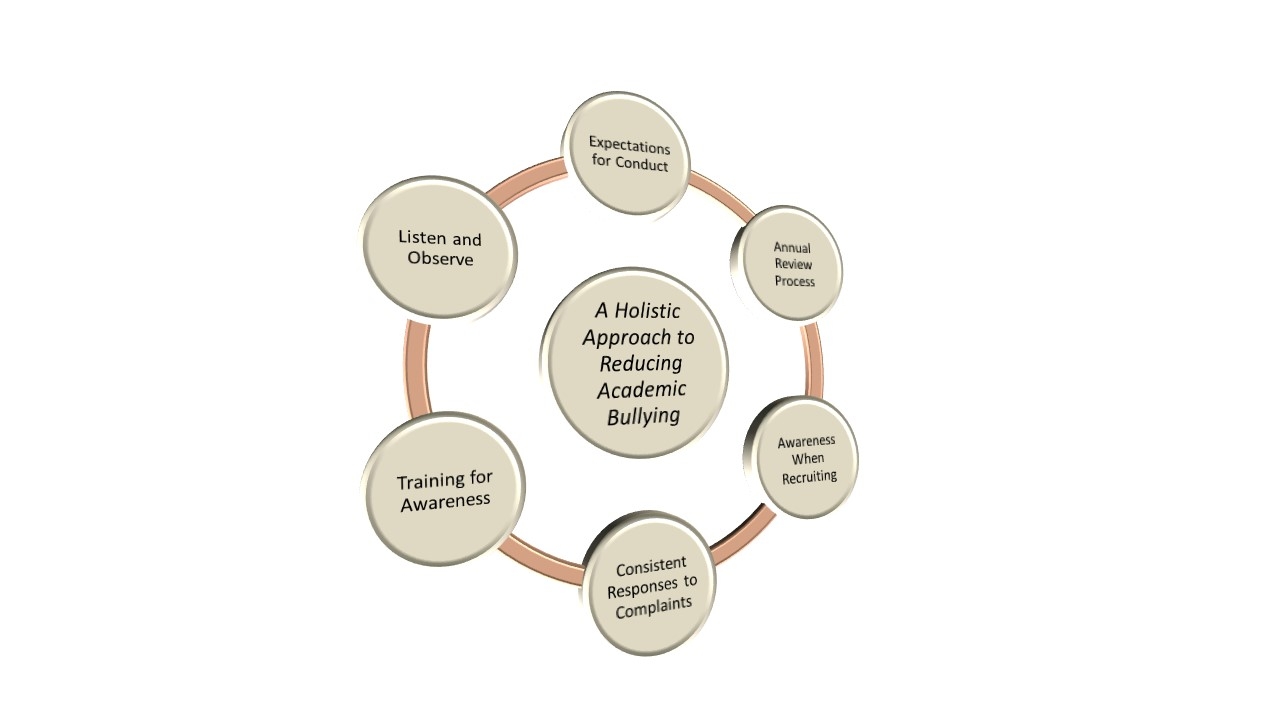Academic bullying is fostered by factors that are extremely common in academia (see video below). Disrupting bullying on an institutional level can be challenging. However, leaders throughout all levels of the university have the power to create the kind of community that allows us to shift the dynamics that foster academic bullying.
To carry forward our Principles of Community we must disrupt academic bullying when we see it in our community. By doing so, we create an open and welcoming environment that can attract and retain excellent students, faculty, and staff.
Creating a bully free environment begins with increased mindfulness of the influence leadership has on the rest of the group. There are a variety of actions you can take to create an environment that decreases the potential for bullying behaviors to negatively impact all of those within the community.
For a primer on what constitutes academic bullying, the different types of bullies, and institutional factors that foster bullying, see the presentation below by Ombudsperson Bryan Hanson.
We encourage you to share this information with those in your immediate community. If you would like support in this effort, Bryan could assist by leading the conversation or presenting this material to your department, program, or group, please contact him at bryanh76@vt.edu or (540) 231-9573.

Actions that you may be able to do in your peer group, club, professional group, department and/or college to help create a bully free environment include:
- Set expectations for conduct. Codes of conduct or ground rules for working together are effective tools for setting expectations. They also provide an easy way to intervene when individuals may be acting outside of the stated expectations.
- Provide adequate training. Communicating effectively and providing feedback that is constructive are skills that need continual refinement. Providing training in these areas can ensure that the environment is mindful of the importance of these skills. Trainings on communication and conflict mitigation can be provided through the Graduate Ombudsperson's Office. Other trainings that are available through Virginia Tech may be found at the Virginia Tech Training site.
- Conduct annual reviews. Annual reviews or evaluations can provide opportunities to reinforce awareness of academic bullying. You may also consider a 360 review process. This process allows you to assess performance from not only those that supervise, but also the peers and subordinates of those being evaluated. More information on 360 review processes available here.
- Listen and observe when complaints are made. If someone brings their concern to you, the first thing you need to do is listen. The experience the individual shares is real and you can listen without committing to action until a full understanding is developed. Following the interaction, identify if there is concern that necessitates further action.
- Build trust through consistent, authentic, and transparent responses to complaints. Make sure your words are consistent with your actions. This will help build the trust for those in your environment to speak up when issues emerge.
- Increase awareness during the search/recruitment process. Technical expertise and academic accomplishments are important when filling a position. It is also important to assess interpersonal skills and leadership strategies when trying to create a bully free work environment. Asking targeted questions of the candidates and their references can help uncover important attributes including how they interact with people they may perceive to be lower in the academic hierarchy such as graduate and undergraduate students, and staff. It can also be useful to ask about their communication styles. For resources on how to frame your interview questions, see the links in the Tips to spot a bully in a job interview section on the Disrupting Academic Bullying Library page.
We encourage all leaders of departments or programs to create an action plan to disrupt academic bullying.
Before you start, exploring what academic bullying is via these case studies and viewing the presentation below can help you understand how it may occur in your department or program. With that understanding, you can come up with ways to deal with it constructively. This guide can help you get started on creating an action plan that is appropriate for and relevant to your department or program.


